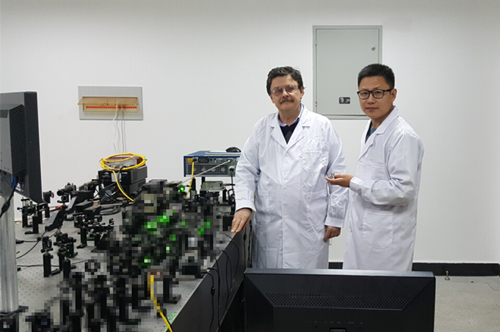
Earth's magnetic field shields us from deadly cosmic radiation, without which life, as we know it, could not exist. But how it first emerged and was then sustained throughout Earth’s history has remained a mystery to scientists.
To explore the mystery, a team led by Alexander Goncharov, a “Thousand Talent Program" member at the Institute of Solid State Physics (ISSP), Hefei Institutes of Physical Science, conducted research that sheds light on the history of this incredibly important geological occurrence. The result of this research was published in Nature in an article entitled, “Direct measurement of thermal conductivity in solid iron at planetary core conditions.”
Our planet is composed of core, mantle and crust. Currently, the inner core is solid iron and the outer core is a liquid iron alloy whose motion gives rise to the magnetic field. But how is heat conducted by the solid of the inner core and the liquid in the outer core? The answer needs to piece together the processes of our planet, its magnetic field, and, even more importantly, the energy that sustains a continuous magnetic field. Only under very extreme conditions, namely, both very high temperature and very intense pressure, do these materials exist, which means that their behavior is not going to be the same as it is on the surface.
"We sensed a pressing need for direct thermal conductivity measurements of core materials under conditions relevant to the core,” Goncharov said. “Because, of course, it is impossible for us to reach anywhere close to Earth’s core and take samples for ourselves.”
Given this situation, his team used a tool called a laser-heated diamond anvil cell to mimic planetary core conditions and study how iron conducts heat under such conditions. The diamond anvil cell squeezes tiny samples of material between two diamonds, mimicking, in the lab, the extreme pressures of the Earth’s interior. The laser heats the materials to necessary core temperatures. Using this kind of lab-based mimicry, the team could study how the core propagates heat.
Through their research, the scientists found that the ability of these iron samples to transmit heat matched the lower end of previous estimates of thermal conductivity in Earth’s core—between 18 and 44 watts per meter per kelvin. This translates to estimates about the energy needed to sustain the geodynamo that has been available since very early in the history of Earth.
"Our measurement provides an estimation of the Fe thermal conductivity in the limits that allow sustaining the geodynamo and simultaneously making the heat losses consistent with a slow Earth’s cooling,” Goncharov added.
As a Global Expert within China’s Thousand Talent Program at ISSP, Alexander Goncharov has led his team to set up state-of-art laboratories to study matter at extreme conditions of pressure and temperature. Last year, he was honored with the 2015 People's Republic of China Friendship Award for his outstanding contribution to the promotion of international cooperation in scientific research.

Prof. Goncharov and post doctoral researcher are conducting laser heating experiments under high pressure (Image by WANG Yuan)

86-10-68597521 (day)
86-10-68597289 (night)

52 Sanlihe Rd., Xicheng District,
Beijing, China (100864)

